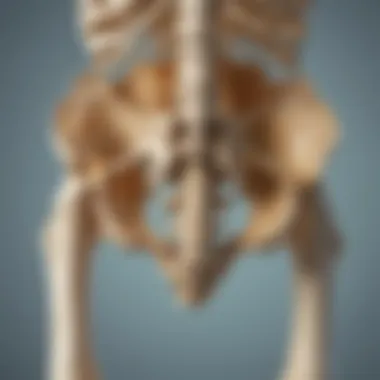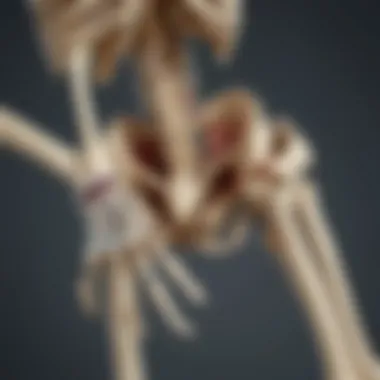Understanding the Human Skeleton: Structure and Significance


Intro
The human skeleton is a fascinating structure. It is much more than just bones; it is an intricate system that provides support and protection for the body. Understanding its functions and anatomy is crucial in both biology and education. This article seeks to explain these aspects, making the information accessible to parents, teachers, and caregivers.
Interactive Learning Games
Learning about the human skeleton can be stimulating and enjoyable through interactive games. They bring a dynamic approach to education, engaging young minds effectively. Here are some popular games designed for this purpose:
Popular Games
- Bone Builder: This interactive 3D game allows players to assemble a human skeleton, learning about each bone's place and function.
- Skeleton Quest: A fun adventure game where players solve puzzles related to the human body.
- Anatomy Arcade: This offers various mini-games focused on anatomy, including the skeletal system.
Description of top educational games
- Bone Builder: Provides sound descriptions and short facts about each bone.
- Skeleton Quest: Offers a mix of learning and adventure, fostering curiosity.
- Anatomy Arcade: It challenges players with quizzes about skeletal structure, deepening their knowledge.
Benefits of playing educational games for kids' cognitive development
Educational games encourage critical thinking and problem-solving. They enhance memory and promote a deeper understanding of complex topics. Such activities also support hand-eye coordination and visual-spatial skills, which are essential in young learners.
Game Reviews
- Bone Builder: Highly rated for its user-friendly interface and engaging visuals. Users appreciate its educational value.
- Skeleton Quest: Favored for its captivating storyline and tasks that make learning fun.
- Anatomy Arcade: Praised for its variety and comprehensiveness regarding the skeletal system.
Comparison of gameplay and learning outcomes
Each game offers unique gameplay experiences, but they all share a common goal: enhancing understanding of the human skeleton. Play often translates into increased knowledge retention, making these games valuable educational tools.
Educational Topics
Learning should be comprehensive, encompassing various subjects. This section includes themes relevant to the skeletal system and additional areas:
- Anatomy & Physiology
- Health Sciences
- Basic Biology
- Environmental Studies
These topics lay the groundwork for interdisciplinary learning. Understanding biology is central to grasping human anatomy, and they mutually reinforce each other.
Tips and Tricks
Educators and parents can improve the learning experience significantly:
- Use visual aids like diagrams or models to demonstrate skeletel structure.
- Encourage questions to promote active participation.
- Connect lessons to real-life scenarios.
Creative DIY Projects
Hands-on activities are excellent for reinforcing knowledge.
Step-by-Step Guides
- Skeleton Art Project: Use pasta or cotton swabs to create a human skeleton model.
- Bone Identification Chart: Provide images of bones for children to label.
These activities promote creativity while enhancing understanding of anatomy.
Craft Ideas
- Pasta Skeletons: Gather different pasta shapes and glue them on a paper to form a skeleton.
- Bone Paintings: Create artwork by tracing actual bone shapes on paper.
Artistic expression is important for cognitive development. Engaging children in creative projects helps solidify their knowledge of complex subjects while allowing for creative freedom.
Understanding the human skeleton is not just about memorizing names; it's about fostering a connection to our own bodies and how they function.
Prologue to the Human Skeleton
Understanding the human skeleton is vital for multiple disciplines, including biology, medicine, and education. This section introduces the complex structure and functions of the skeleton. It lays the foundation for exploring more specific elements of the skeletal system in later sections.
Definition and Importance
The human skeleton serves as the framework for the body. It provides shape and supports other systems, such as the muscular and circulatory systems. The skeleton allows for movement, protection of vital organs, and the production of blood cells. Its importance cannot be overstated. Without a robust and functional skeleton, life as we know it would not be possible.
Overview of the Skeletal System
The skeletal system encompasses various components and types of bones, each with unique functions. This section provides a thorough look into these aspects, creating a comprehensive understanding of what the human skeleton entails.


Major Components
The major components of the skeletal system include the skull, vertebral column, and rib cage, among others. Each of these elements contributes to the system’s overall goal of providing stability and protection to the body. The skull, for instance, encases the brain and forms the structure of the face. This targeted protection is what makes it a crucial part of the system.
Key characteristic: The human skeleton consists of 206 bones arranged in a specific manner to optimize functionality. This configuration allows movements and support that are essential in daily life.
Unique feature: The modularity of bone structure permits adaptability to varying physical conditions. This adaptability can be advantageous for learning and adapting to environmental factors.
Types of Bones
There are several types of bones: long bones, short bones, flat bones, and irregular bones. Each type has distinct characteristics and serves different functions within the skeletal framework. Long bones, like the femur, are essential for supporting weight and facilitating movement.
Key characteristic: The length of long bones makes them effective in bearing weight. This is useful for understanding weight distribution in the body.
Unique feature: Variations in bone density among different types influence their strength and durability, impacting overall skeletal health.
Skeletal Functions
The functions of the skeletal system extend beyond mere support. They include movement, blood cell production, and the storage of minerals such as calcium.
Key characteristic: The ability of bones to produce blood cells is particularly significant, as it affects numerous bodily functions and overall health.
Unique feature: The skeletal system serves as a reservoir for minerals, essential for various physiological processes. This dual role makes it a complex system that supports life in multiple ways.
By grasping these fundamental concepts, readers gain deeper awareness of the skeleton's role in human biology. This informs not only medical understanding but also educational approaches that can enhance learning experiences for children and caregivers.
3D Model Representation
The use of 3D models in educational settings has revolutionized the way complex subjects, like the human skeleton, are taught. This section explores how 3D models serve as an effective tool in enhancing comprehension and engagement. By presenting detailed visual representations, these models help bridge the gap between theoretical knowledge and practical understanding. They create a platform where learners can interact with, observe, and analyze the intricate details of the human skeleton in a way that traditional methods might not achieve.
Preface to 3D Models
3D models are digital representations that provide a three-dimensional perspective of objects. In the context of the human skeleton, these models allow us to visualize bones, joints, and entire structures from various angles. This representation helps learners grasp proportions, spatial relationships, and anatomical details that flat images cannot convey. The clarity of 3D modeling plays a critical role in enhancing anatomy learning. It is particularly helpful for children and students, making complex information more accessible and engaging.
Benefits of Using 3D Models for Learning
Enhanced Visualization
One of the primary advantages of enhanced visualization is the clarity it offers. By visualizing the human skeleton in three dimensions, students can understand the size, shape, and location of various bones much better. This aspect promotes an accurate mental image, which is critical for learning anatomy. The key characteristic of enhanced visualization is its ability to provide detailed views of structures, something traditional textbooks often lack.
- Benefits: This deep insight aids memory retention and recall. It can be particularly beneficial for younger audiences who may struggle to visualize abstract concepts.
- Limitations: However, the reliance on technology for learning may lead to challenges for students without access to these resources.
Interactive Learning
Interactive learning fosters active participation. Using 3D models, learners can interact directly with the representation. They can rotate, zoom in or out, and explore specific areas in detail—actions which enhance their understanding. The key characteristic here lies in the engagement levels that 3D models inspire. When children can manipulate what they are learning, they are more likely to retain information.
- Unique Feature: The ability to explore a subject from multiple angles allows for a comprehensive understanding of anatomical relationships and functions.
- Drawback: On the other hand, interactive learning models require guidance to maintain focus on relevant aspects. Without effective direction, students may become overwhelmed by the myriad of information available.
Engagement with Content
Engagement is paramount in the learning process. 3D models captivate attention through their visual nature and interactivity. When learners feel more engaged, they are likely to invest time and effort into understanding the subject matter. The involvement offered by 3D models encourages curiosity and motivates students to delve deeper into skeletal biology.
- Key Characteristic: The immersion they provide can lead to a more effective educational experience, making learning enjoyable and informative.
- Challenges: However, inappropriate use or over-reliance on 3D models may lead to superficial learning if students become too focused on visuals rather than underlying concepts.
Detailed Structure of the Human Skeleton
The structure of the human skeleton is fundamental to understanding the complexities of human anatomy. It serves as the framework for the body, playing a vital role in protecting vital organs, facilitating movement, and supporting overall body posture. The detailed examination of the skeleton reveals its intricacies, and provides insight into how each component contributes to the larger system. This section aims to outline the components of both the axial and appendicular skeletons, detailing their unique features.
Axial Skeleton
The axial skeleton consists of the skull, spinal column, and rib cage. This part of the skeleton is essential for protecting the central nervous system and provides a stable base for attachment of muscles. Its importance in the overall skeletal structure cannot be overstated.
Skull
The skull is the bony structure that encases the brain. It has numerous openings which allow for the passage of nerves and blood vessels. A key characteristic of the skull is its immovable sutures that fuse its bones together, offering maximum protection. The use of the skull in educational materials is quite beneficial since it helps illustrate concepts related to cranial anatomy and brain protection. A unique feature of the skull is its ability to adapt slightly during childbirth, allowing the baby's head to fit through the birth canal. While the rigidity of the skull provides protection, it also poses challenges in terms of cranial injuries that can have serious implications.
Spinal Column
The spinal column, or vertebral column, consists of vertebrae stacked one atop the other, forming a flexible yet sturdy structure. It plays a crucial role in protecting the spinal cord, which is a major component of the central nervous system. The key characteristic of the spinal column is its ability to support upright posture and allow for a range of movements, including bending and twisting. This flexibility is one reason why it is a favored topic in anatomy education. A unique feature of the spinal column is that it has natural curves, which help distribute the load during movement. However, structural anomalies can lead to conditions such as scoliosis, which affects overall posture and mobility.
Rib Cage


The rib cage is a bony enclosure that protects the heart and lungs. It forms a shield around these vital organs, playing a key role in respiration. The ribs both expand and contract during breathing, highlighting their dynamic nature. This aspect makes the rib cage a beneficial focus for educators explaining the respiratory system. A distinct feature of the rib cage is its elasticity, which allows for expansion when inhaling. While it is primarily protective, trauma to the rib cage can lead to complications such as pneumothorax, indicating that, despite its strength, it is not immune to injury.
Appendicular Skeleton
The appendicular skeleton is composed of the limbs and girdles, facilitating movement aiding balance. This part of the skeleton is essential for various activities, ranging from basic locomotion to intricate tasks requiring fine motor skills.
Arms and Hands
The arms and hands enable a wide range of movements and are crucial for interaction with the environment. They are characterized by their complex structure, especially in the hands, where many small bones allow for precision grip. This close coordination makes them a popular subject in anatomy education, as understanding their mechanics is essential for grasping larger concepts of human movement. A unique feature of the human hand is its opposable thumb, which allows for grasping and manipulation of objects. While the dexterity of hands is a strong advantage, it also means they are more susceptible to repetitive strain injuries.
Legs and Feet
The legs and feet are important for supporting the body's weight and facilitating movement. A key characteristic of the legs is their ability to absorb shock during activities like walking and running. This attribute makes learning about the legs and feet relevant for discussions on biomechanics. A unique feature of the foot is its arch structure, which provides resilience and helps in balance. However, foot-related ailments like plantar fasciitis can significantly impact mobility, reminding us of the importance of foot health.
Girdles
The girdles consist of the pelvic and shoulder girdles, connecting the limbs to the axial skeleton. The shoulder girdle enables a wide range of motion in the arms while the pelvic girdle supports the weight of the upper body. This dual functionality makes them particularly interesting in the study of human movement and stability. The pelvic girdle's ability to house reproductive organs is an important feature in biological discussions. However, the design can lead to complications such as fractures in high-impact situations, underscoring the balance between mobility and safety.
Understanding the detailed structure of the human skeleton provides clarity on the complexities of anatomy and its functional importance, especially when it comes to education for younger audiences.
Understanding Bone Physiology
Bone physiology is essential for comprehending the complex framework that supports the human body. It addresses how bones grow, develop, and function throughout different stages of life. Understanding this topic provides insights into skeletal health, which is crucial for parents, teachers, and caregivers in guiding children's growth and physical activities. This exploration not only highlights the biological processes involved but also connects to broader educational applications.
Bone Composition
Cell Types
Cell types within bone are fundamental to its formation and maintenance. The primary cell types include osteoblasts, osteocytes, and osteoclasts. Osteoblasts are responsible for bone formation, while osteocytes maintain bone tissue. Osteoclasts, on the other hand, help in the resorption of bone. This dynamic between these cells is vital for achieving balance in bone mass. Understanding these cells can guide individuals in choosing exercises and nutritional approaches that support their development.
A unique feature of these cells is their interdependence. For instance, osteoblasts and osteoclasts work together to remodel bones, which is particularly important during growth spurts in children. Knowledge about cell types fosters a deeper understanding of skeletal health and informs decisions regarding physical activity, diet, and lifestyle.
Bone Matrix
The bone matrix is the supportive structure that provides strength and flexibility to bones. It consists mainly of collagen fibers and inorganic mineral components, such as hydroxyapatite. The key characteristic of the bone matrix is its ability to withstand compressive forces while remaining somewhat flexible. This duality makes it especially beneficial for physical activities, which require both strength and resilience.
A unique feature of the bone matrix is its ability to adapt in response to stress. When bones undergo mechanical load, they strengthen through a process known as bone remodeling. This presents both advantages and disadvantages; while essential for adaptation, excessive strain can lead to injuries. Understanding the bone matrix helps caregivers explain the importance of balanced physical activity to children.
Mineralization
Mineralization is the process through which minerals, primarily calcium and phosphate, are deposited in the bone matrix. This process enhances bone density and strength. A significant aspect of mineralization is that it determines how robust bones are against fractures. Ensuring adequate mineralization in growing children is critical to support their active lifestyles.
A unique feature of mineralization is the balance between the deposition and resorption processes. If there is too much resorption without adequate deposition, it can lead to weakened bones. For parents and caregivers, understanding mineralization is vital for promoting dietary choices rich in calcium and vitamin D, which are essential for proper bone health.
Bone Growth and Development
Bone growth and development is a continuous process that occurs throughout childhood, adolescence, and adulthood. This journey impacts not only physical stature but also overall health.
Childhood Development
During childhood, bones grow and develop rapidly. This growth is influenced by genetics, nutrition, and physical activity. A key characteristic of childhood development is that it lays the groundwork for long-term bone health. It is beneficial for children to engage in weight-bearing activities, which stimulate bone density.
A unique feature of this stage is the pronounced growth spurts. These spurts require increased nutrient intake, particularly calcium and protein. Understanding childhood development helps caregivers establish encouraging environments that promote healthy habits early on.
Adolescence
Adolescence marks a pivotal stage in bone development due to the second major growth spurt. During this time, bones can grow in both length and density. Recognizing this key characteristic is crucial, as it helps inform parents about the need for increased caloric and nutrient intake.
A unique feature of adolescence related to bone health is the impact of hormonal changes. Hormones significantly influence how bones mature. This understanding encourages discussions about the importance of nutrition and exercise, as both are vital in optimizing bone health during this transformative period.
Adulthood Changes
As individuals transition into adulthood, the focus shifts from growth to maintenance. Bone density peaks in early adulthood, after which gradual bone loss can begin. A beneficial aspect of understanding this transition is that it allows for proactive measures to sustain bone health through diet and exercise.
A unique feature of adulthood changes is that lifestyle choices made during earlier years significantly affect bone health later in life. Awareness of this concept encourages continuous education about healthy habits. Teaching individuals about their bone health empowers them to take charge of their wellbeing long-term.
Skeletal Health and Preservation
The health of the skeleton is crucial, influencing overall well-being and quality of life. A strong and healthy skeletal system supports movement, protects vital organs, and serves as a site for blood cell production. This section will cover common skeletal disorders that can affect individuals and explore methods to maintain and improve bone health through proper nutrition and exercise.
Common Skeletal Disorders


Osteoporosis
Osteoporosis is a condition characterized by weakened bones, which increases the risk of fractures. It often occurs without symptoms until a fracture happens. The critical aspect of osteoporosis is that it can affect people of all ages, but it is most common in older adults. It is a key consideration in understanding skeletal health.
The unique feature of osteoporosis lies in its preventable nature through lifestyle choices.
Advantages: Awareness and preventive measures can reduce risks significantly.
Disadvantages: Once significant bone loss occurs, reversing osteoporosis becomes much more challenging.
Arthritis
Arthritis refers to inflammation of the joints, causing pain and stiffness. This condition affects mobility and can lead to diminished quality of life. It is a popular topic in discussions about skeletal health because it is widespread and affects people of all ages. A key characteristic of arthritis is its ability to flare up, which leads to sporadic pain.
The unique feature of arthritis is the various types, including osteoarthritis and rheumatoid arthritis, each requiring different management strategies.
Advantages: Many treatments are available to manage pain and improve function.
Disadvantages: With time, arthritis can lead to further joint damage, complicating treatment plans.
Scoliosis
Scoliosis is defined by an abnormal curvature of the spine. It is significant in the context of skeletal health because it can impact posture and lead to additional health issues. The key characteristic of scoliosis is its variability; some cases are mild and do not require treatment, while others may need surgical intervention.
This condition raises awareness of how spinal alignment is important for overall health.
Advantages: Early detection can lead to better outcomes and management.
Disadvantages: Severe scoliosis can lead to complications such as chronic pain and reduced lung capacity.
Maintaining Bone Health
Nutritional Considerations
Nutrition plays a vital role in maintaining bone health. Essential nutrients include calcium and vitamin D, which are critical for bone density. The key characteristic of these nutrients is their availability through various foods and supplements. Focusing on nutritional needs is beneficial in delaying bone density loss, especially in older adults.
Advantages: A balanced diet can strengthen bones and reduce the risk of fractures.
Disadvantages: Relying solely on supplements without proper dietary intake can be less effective.
Exercise and Activity
Regular physical activity is crucial for healthier bones. Weight-bearing exercises can strengthen bones and prevent osteoporosis. The key aspect is that both children and adults benefit from maintaining an active lifestyle. Integrating exercise into daily routines is a beneficial approach to increasing bone density. Advantages: Physical activity leads to better muscle strength and balance, reducing fall risk. Disadvantages: Inactivity can lead to weaker bones and increase health risks associated with a sedentary lifestyle.
Preventive Measures
Preventive measures are essential to ensure long-term skeletal health. This includes regular check-ups with healthcare providers, especially for those at higher risk of skeletal disorders. The key characteristic is that prevention must start early in life, as strong bones in youth can lead to better outcomes in adulthood.
Advantages: Proactive monitoring and lifestyle changes can significantly decrease the risk of developing severe skeletal conditions.
Disadvantages: Neglecting bone health until symptoms appear may lead to irreversible damage.
Educational Applications
The exploration of the human skeleton is vital in educational settings. It provides a solid foundation for understanding anatomy and biology. A clear grasp of the skeletal system aids in appreciating the body’s functions and health. By integrating educational applications, teachers and caregivers can enhance children's learning experiences, making anatomy more accessible and engaging.
Teaching Anatomy through 3D Models
3D models revolutionize the way anatomy is taught. They create a realistic representation of the human skeleton. This helps students visualize structures more effectively than traditional methods. Most importantly, these models enable hands-on learning. By manipulating the models, learners gain a deeper understanding of bone placements and functions.
Teachers using 3D models report improved retention in students. Seeing the skeletal system in three dimensions aids in memory recall. Furthermore, these models can be made interactive. This engagement supports various learning styles, accommodating both visual and kinesthetic learners.
Integrating Technology in Education
The integration of technology into education is transformative. It enhances the way students engage with content. Technology activates students' curiosity, driving them to explore topics in depth. Interactive tools can turn learning into an engaging experience.
Interactive Learning Modules
Interactive learning modules stand out as effective tools for education. They combine visual and auditory elements, making complex topics easier to grasp. These modules adapt to various learning speeds, allowing students to progress at their own pace.
A key characteristic of these modules is their ability to provide instant feedback. Learners can quickly assess their understanding and adjust their study tactics. This interactivity makes them a popular choice for teaching anatomy. However, they require a reliable tech setup—something that might not be available everywhere.
Supplementary Resources
Supplementary resources complement core educational materials effectively. They provide additional context and examples, reinforcing key concepts. These resources can include videos, articles, or quizzes. The variety ensures different learners find suitable materials for their needs.
They are beneficial as they can introduce real-life applications of anatomy topics. These resources are accessible online, allowing learners to explore at their convenience. Yet, they may not always align with the main curriculum, potentially causing confusion.
Virtual Field Trips
Virtual field trips offer unique insights into human anatomy. These experiences allow students to explore museums or anatomy labs from anywhere. A major advantage is that it exposes students to expert knowledge. They can learn directly from specialists in the field.
The interactive nature of virtual field trips helps maintain engagement. Students feel as if they are part of the exploration, making learning enjoyable. However, internet access is crucial for effective participation. Without it, students may miss out on these rich educational experiences.
"Technology in education breaks barriers and bridges gaps in knowledge."
By understanding and utilizing these educational applications, teachers and caregivers can effectively support children in grasping the complexities of the human skeleton. This ensures a robust educational experience that is engaging and informative.
Finale
The conclusion section brings together the essential themes discussed throughout the article. It emphasizes the importance of understanding the human skeleton, not just for scientific knowledge, but also for its educational implications. By grasping how the skeleton functions, individuals can appreciate the complexity of the human body. This understanding lays a foundation for further studies in biology and health.
Summary of Key Points
In summarizing the key insights from the article, several crucial points emerge:
- Definition and Importance: The skeleton serves as the structural framework of the body, protecting vital organs and enabling movement.
- 3D Models: Utilizing 3D models in education enhances comprehension by providing a tangible way to interact with anatomical structures.
- Bone Physiology: Understanding the composition and growth of bones is essential for recognizing how they contribute to overall health.
- Skeletal Health: Awareness of common disorders and measures for maintaining bone health is vital for lifelong well-being.
- Educational Approaches: Integrating technology in teaching about the skeleton can significantly impact learning experiences, especially for children.
By consolidating these points, we can see how each aspect serves a purpose in enriching our understanding of human anatomy.
Future of Learning about the Skeleton
Looking ahead, the future of learning about the skeleton holds exciting prospects. The integration of technology will likely continue to reshape educational methodologies. Here are some considerations:
- Innovative Tools: The use of virtual reality and augmented reality may enhance how learners engage with skeletal structures, making anatomy more accessible.
- Collaborative Learning: Online platforms may foster collaborative learning environments where students can explore skeleton-related projects more interactively.
- Interdisciplinary Approaches: There is potential for combining biology with art and technology, creating a holistic learning model that caters to various interests.
- Global Resources: As online resources become more abundant, students from diverse backgrounds can access quality information about the skeletal system.















